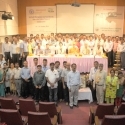West Bengal - Region Profile
West Bengal is one of the most important states of eastern India. The state capital i.e. Kolkata is so far the only metropolitan city and therefore the biggest business hub of eastern India. Geographically this is also a very important state as lying between 21°25'24” and 27°13'15” north latitudes and 85°48'20” and 89°53'04” east longitudes, the State of West Bengal shares its borders with three different nations – Bangladesh, Bhutan and Nepal – and four other Indian States, viz. Odisha, Jharkhand, Assam and Sikkim. It has a total geographical area of 8.875 million hectares. Total population of the state is about 91.3 million people with a population density of 904 per sq. km. Nearly 30% of the state's income comes from agriculture. The state produces more than 15% of total rice production in the country. West Bengal also accounts for 72% of the country's jute, 34% of potato and 22.9% of tea production. Cropped area covers 5.47 million hectares with a cropping intensity of 174.4%. However, only 35 per cent of the cropped area are irrigated. Current food-grain production of the state is 14.4 million tonnes (Mt). Table 1 illustrates the current area, productivity and production statistics of major crops in West Bengal.
Nutrient consumption in West Bengal in the past decade is given in Fig. 2. Total fertilizer nutrient consumption in West Bengal declined from 1.560 million MT during 2012-13 to 1.227 million MT during 2013-14 representing a negative growth of 21.4%. Total nutrient consumption declined in both the seasons. Kharif: Rabi share in total fertilizer consumption changed from 38:62 during 2012-13 to 39:61 during 2013-14. Nutrient-wise break up shows negative growth in all the three nutrients during 2013-14. The consumption of N at 0.693 million MT, P2O5 at 0.263 million MT and K2O at 0.271 million MT during 2013-14 registered decline of 15.9%, 42% and 4.2% respectively, over 2012-13. NPK use ratio changed from 2.9:1.6:1 to 2.6:1:1 during the period. Per hectare use of total fertilizer nutrients reduced from 166.8 kg to 131.2 kg during the period. Using the area and production of major crops, the total nutrient (N, P2O5 and K2O) removal by each crop was calculated and a nutrient balance sheet was prepared (table 2).
Table 1: Latest Crop Production Statistics of West Bengal-2012-13
| Parameters | Rice | Wheat | Maize | Total Cereals | Total Pulses | Total Foodgrains | Groundnut | Total Oilseeds | Jute# | Sugarcane |
| Area | 5444.3 | 321.6 | 105.6 | 5887.1 | 201.9 | 6089.0 | 67.5 | 732.1 | 576.7 | 16.1 |
| Production | 15023.7 | 895.9 | 416.8 | 16354.2 | 192.3 | 16546.5 | 170.5 | 850.7 | 8228.2 | 1617.0 |
| Productivity | 2760 | 2786 | 3947 | 2778 | 952 | 2717 | 2526 | 1162 | 2568 | 100437 |
Area ('000 ha); Production ('000 tonnes); Productivity (kg/ha); # Production and Productivity in 1000 bales of 180 kg each
Table 2: Nutrient balance sheet for major crops of West Bengal (2012-13)
| Crop | Area (in '000 ha) | Production (in '000 tonnes) | Nutrient Removal (kg/tonne) | Total Removal (tonnes) | ||||
| N | P2O5 | K2O | N | P2O5 | K2O | |||
| Rice | 5444.3 | 15023.7 | 20.1 | 11.2 | 30 | 301976.37 | 168265.4 | 450711 |
| Wheat | 321.6 | 895.9 | 24.4 | 8.6 | 32.8 | 21859.96 | 7704.74 | 29385.52 |
| Maize | 105.6 | 416.8 | 8.2 | 3.1 | 15.5 | 3417.76 | 1292.08 | 6460.4 |
| Total Pulses | 201.9 | 192.3 | 40 | 5 | 20 | 7692 | 961.5 | 3846 |
| Total Oilseeds | 732.1 | 850.7 | 54 | 14 | 46 | 45937.8 | 11909.8 | 39132.2 |
| Sugarcane | 16.1 | 1617 | 1.7 | 0.2 | 2 | 2748.9 | 323.4 | 3234 |
| Jute | 576.7 | 8228.2 | 23.5 | 13 | 41.7 | 193362.7 | 106966.6 | 343115.94 |
Total removal by major crops | 576995.49 | 297423.6 | 875885.06 | |||||
Total fertilizer consumption in West Bengal | 824000 | 453670 | 282730 | |||||
Consumption * Efficiency factor | 329600 | 136101 | 197911 | |||||
Balance/Deficit | -247395.49 | -161322.6 | -677974.06 | |||||
*Crop production and fertilizer use data are retrieved from Fertiliser Statistics, 2013-14, The Fertiliser Association of India, New Delhi


